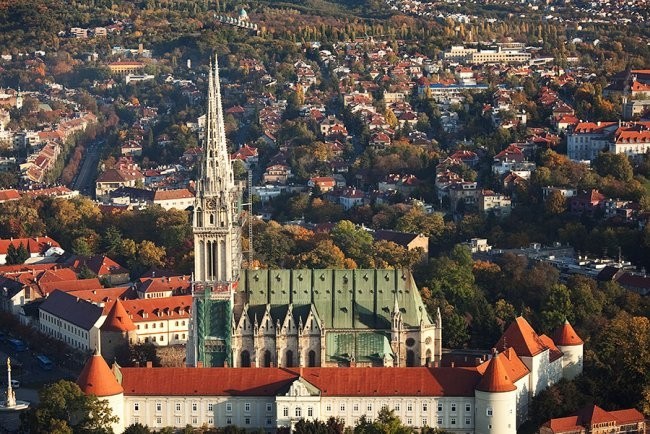Alex Kapranos (Franz Ferdinand) wrote about Zagreb on his blog: http://bit.ly/nO3yin
Source: www.guardian.co.uk

The Zagreb Cathedral is the most monumental and the most impressive Gothic-style sacral building southeast of the Alps. Its ground plan, with slender cross-ribbed arches within three polygonal apses with narrow windows, resembles French architectural pattern (ex. the one in Troyes); the details of its subsequently added naves (of equal height) correspond to the building patterns of modern German architecture; imaginative sculptures, on the other hand, reflect influence of Czech schools.
All this indicates not only early introducation of Gothic style to Croatia's north and internationalization of art, but also the importance of Zagreb Bishopric and the status and power of its bishops in those days. From the very beginning, the cathedral was dedicated to the Blessed Virgin mary, i.e. to the Assumption of the Blessed Virgin Mary (Feast of the Assumption). Although Hungarian King St. Stephen is always mentioned as the primary patron-saint, he is actually the second one.
Most likely, king Ladislaus (1040 - 1095) did not build a new cathedral after the founding of Zagreb Bishopric; instead, he proclaimed the existing one a cathedral.
Construction of the new cathedral began after his death. The cathedral was finished in 1217 and was consecrated by King Andrew II (1205 - 1235), on his way to the 5th Crusade. As early as in 1242, Tartars destroyed the newly built cathedral, so Bishop Stephen II (1225 - 1247) had the Chapel of St.Stephen the Martyr erected for the cathedral mass services. this Romanesque and Gothic building is today incorporated in the Archbishopric's Seat.
Bishop Timotej (1263 - 1287) started building a new, monumental cathedral, integrating in it the remainders of the 'preTartaric' cathedral. He dedicated it to St.Stephen, a Hungarian king. He managed to build the central apse and the two side ones with altars, as well as the sacristy. The frescoes in the sacristy (interestingly, St. Kvirin between St. Dominic and St. Francis) probably date back from the time of Bishop Augustin kažotić (1303 - 1322). Bishop Eberhard (1397 - 1406 and 1410 - 1419) deserves credit for the building of three church naves the evidence of which can be seen on his bishop's coat of arms on walls and pillars).
Bishop Osvald Thuz (1466 - 1499) roofed the whole building. Building of the steeple on the south side of the front started at that time; this renaissance and baroque steeple was not finished before the 17th century. Turkish threat forced bishop Thuz to start building fortifications around the cathedral. It was not before 1517 that they werw finished, by Ostrogon Archbishop Toma Bakač, the head of Zagreb Bishopric. He built a tower in front of the cathedral's entrance. It was named after him - the Bakač Tower. It was pulled down during the last reconstruction of the cathedral in 1906.
During the 17th century, fire damaged the cathedral several times, but every next reconstruction enriched its interior with valuable inventory. This includes baroque altars (wooden and marble ones) and a pulpit by sculptor Mihael Cusse (the latter one can still be seen in the central nave). Enriching of the cathedral's interior continued. Bishop Aleksandar Alagović (1829 - 1837) acquired the painting Assumption of Virgin Mary, that was installed on the altar, and a loft. Archbishop Juraj Haulik (1837 - 1869) removed the altar painting (he sold it to the parish church in Pregrada). Instead, he built the neogothic, main altar. Also, in 1855, he bought a large organ (with three manuals, one pedal and 53 registers), made by Walcker Company from Ludwigsburg.
The architecture of the organ-closet has neo-gothic features. Finally, Haulik had the shrine windows painted. Those are the oldest stained-glass windows in Croatia. In an attempt to restore the cathedral's original appearance, Viennese professor of Architecture Friedrich Schmidt was invited to Zagreb. He took his student Hermann Bolle with him. However, the cathedral was severely damaged by the disastrous earthquake of 1880. For this reason, not only it was reconstructed according to the design of H. Bolle, but its interior also acquired neo-gothic characteristics. That was especially clear/emphasized by the arches of the two neo-gothic bell towers(bells) , which hight is around 105m. Therefore the today's look of the Cathedral was finalized in 1902 year. In the past 30 years, substantial reconstruction works have been undertaken on the cathedral.
Since low-quality stone was used during Bolle's reconstruction (economic reasons and the vicinity of Bizek and Vrapče quarries), particularly on the new steeples and on the western facade, it soon started to deteriorate, affected by weather and city pollution (smog and chemical factors). The deterioration was first spoted on the cathedral's facade and on stone sculptures (ex.lanterns with pinnacles) that were now out of recognition. The first reconstruction of a part of the southern steeple started in 1938, but was stopped when communists came to power. It was reassumed in 1968, when the top of the northern steeple was renovated. Subsequently, mostly owing to donations from Croatian Diaspora, the worn-out roof was completely renovated and replaced with copper plates.
In 1987, Archbishop Franjo Kuharić founded the Zagreb Archbishopric's Committee for Reconstruction of the Cathedral, as well as a task force of selected experts. Soon, the Cathedral Reconstruction Monitoring Committee was also founded and scientific and art institutions and the city and state authorities took part in its activities. After architects and assessors of conservationist and restoration works had been selected, the reconstruction started in 1990. It has been going on ever since, by phases and priorities. The Committee publishes the periodical Our Cathedral, reporting on current status of the works.